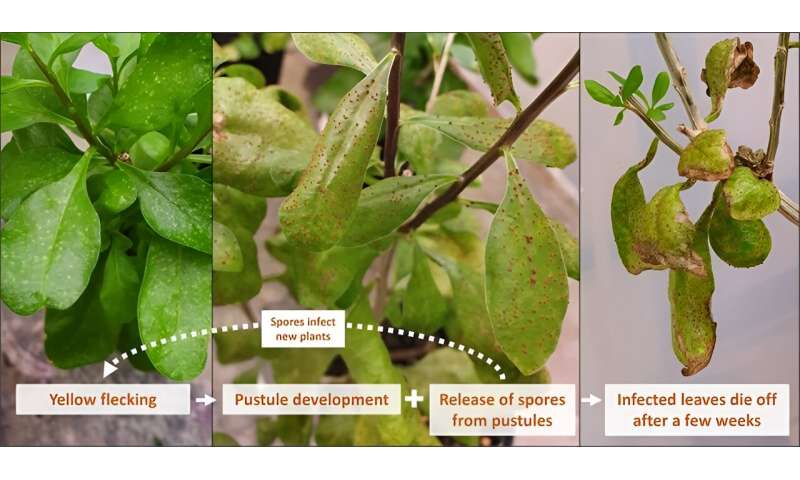Rust fungus biocontrol agent tackles invasive weed African Boxthorn in New South Wales

A new rust fungus biocontrol agent for African Boxthorn weed is out of the lab and into the field. The program includes a targeted release, monitoring and evaluation program in New South Wales.
The program is being delivered in partnership with weed managers, landholders and volunteer community groups.
As the rust fungus establishes, it is expected to reduce the growth and spread of African Boxthorn.
A prickly problem
African Boxthorn (Lycium ferocissimum) is an environmental and agricultural weed widespread across regional Australia.
It's difficult to control as it forms dense, impenetrable and thorny thickets.
Current physical and chemical control measures are expensive and undesirable for use in environmentally sensitive areas, like along creeklines. Classical biocontrol is a safe, science-based, cost-effective and sustainable method of weed control.
Enter: rust fungus Puccinia rapipes.
Rust fungus to the rescue for weed management
We identified a potential biocontrol agent: the rust fungus (Puccinia rapipes). It comes from the same area as African Boxthorn in South Africa. Our rigorous testing showed it to be safe for release into the Australian environment, with no risk of damage to native plant species.
Dr. Ben Gooden is a plant scientist and leader of our Temperate Weeds team.
"We carried out extensive host-specificity testing at a quarantine facility," Ben said.
"This involved exposing non-target plant species, including native flora, to the rust fungus under optimal conditions for infection."
The fungus was not able to reproduce on native plant species. It was deemed by regulators to be safe for release into the Australian environment. Once released, it causes yellowing of the leaves followed by the development of pustules that swell up and release fungal spores. These fungal spores then go on to infect nearby plants.
"In the long term, we predict this rust fungus will reduce the reproductive output and growth of African Boxthorn under conditions supporting fungal growth. This can help reduce further spread of the weed," Ben said.
The fungus will take several years to establish. Broader biocontrol benefits may only be apparent over years or even decades once the fungus is found far and wide across Australia.
Releasing the rust fungus in NSW
We've kicked off coordinated releases of the fungus across the Central West region of NSW, with weed management field days held in Warren and Coonamble. These events, hosted by Central West Local Land Services and Castlereagh Macquarie County Council, resulted in more than 50 expressions of interest to participate in the program.
Jodie Lawler is a Regional Weeds Coordinator at Central West Local Land Services NSW. She said there had been an incredible response to the field days, with about 80 participants in Warren and 65 in Coonamble.
"Ben was such a drawcard. He explained the process of how to apply the biocontrol fungus and pointed out that while it isn't a silver bullet, over time it will have an impact for land managers," Jodie said.
"Farmers said one of the best things about the field days was seeing how many of their neighbors were there. It just brought everyone together so it can be a bit of a community approach to this serious weed."
Andrea Fletcher-Dawson is the Senior Biosecurity Weeds Officer at Castlereagh Macquarie County Council. She said African Boxthorn is a major weed across the five shires she works in: the Warrumbungle, Walgett, Coonamble, Gilgandra and Warren shires in Central West NSW.
"It's a big problem for livestock because it takes over the areas under trees. Then the stock can't get in there because of all the thorns. So, they can't access that shade and shelter when they need to," Andrea said.
"The field days were so popular. Most of the participants weren't aware there was a biocontrol agent for African Boxthorn. Everyone was so inspired. They just can't wait to get their hands on the rust fungus.
"I've worked with a lot of other biocontrol projects, so I know the importance of patience, waiting for the biocontrol agent to establish in the field. Ben did a lot of explaining that this doesn't kill the plant straight away. He explained what it actually does to the plant and how long it will take.
"There's also a lot to consider when applying this control method—the soil type, whether the site is shaded and what the weather's doing," she said.
Provided by CSIRO